The Overseas Highway: The US’ ‘floating’ highway

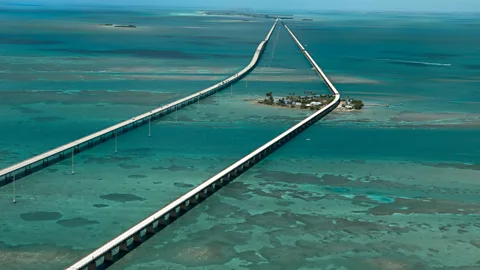 Johnny Stockshooter/Alamy
Johnny Stockshooter/AlamyAs many Americans hit the road this weekend to kick off the unofficial start of summer in the US, we’re revisiting one of our favourite road trip stories about an engineering marvel stretching 113 miles into the ocean that forever changed Florida.
Seagulls cried overhead as I glided across miles of glistening waters somewhere between the Atlantic Ocean and the Gulf of Mexico. The sky melted into the teal sea, which turned turquoise as it shallowed into channels between the coral and limestone islands. It was a tableau of blue, extending as far as I could see.
As I adjusted my sunglasses, I glimpsed a blur of movement from the corner of my eye. A bottlenose dolphin! It had friends, and soon the pod performed an aquatic ballet, leaping in graceful arcs before plunging back into the waves. Fishing boats bobbed lazily around me, and I had an urge to cast a line, but it would have been hard to do while driving at 50mph along a highway.
Travelling from Miami to the island of Key West, Florida, hasn’t always been the carefree drive it is today. In the early part of the 20th Century, the only way to make the journey to the southernmost point in the continental US was a day-long boat ride, and that was dependent on weather and tides. But thanks to a stunning engineering marvel known as the Overseas Highway that stretches 113 miles from the mainland’s southern tip across 44 tropical islands on 42 bridges, I was seemingly floating across a necklace of mangrove forests and cays as I drove to a place where North America and the Caribbean meet.
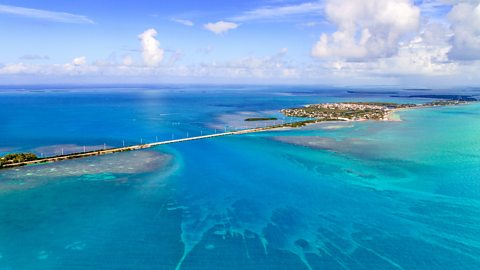 Robert Zehetmayer/Alamy
Robert Zehetmayer/AlamyThe Overseas Highway actually started as the Over-Sea Railroad, and it was the brainchild of visionary developer Henry Morrison Flagler (known as “The Father of Modern Florida”). In 1870, Flagler co-founded the Standard Oil Company alongside business magnate John D Rockefeller, and it became one of the world’s largest and most powerful corporations at the beginning of the 20th Century. After visiting Florida and recognising “The Sunshine State’s” tourism potential, Flagler poured much of his wealth into the region, building luxury resorts that transformed one of the US’ poorest states into a winter paradise for Gilded-Age travellers from the Northeast US. Yet, there was no way for guests to get to Flagler’s opulent-but-remote resorts.
So in 1885, Flagler connected a series of disjointed railroads along Florida’s Atlantic Coast from Jacksonville, at Florida’s northern end, to Miami, near the state’s southern tip. Miami should have been the end of the line, but when the US began construction on the Panama Canal in 1904, Flagler saw tremendous potential for Key West – the US’ closest piece of land to the Canal and the deepest port in the Southeast US. The bustling hub was already flourishing thanks to the cigar, sponging and fishing industries (Key West was Florida’s largest city until 1900), but the island’s remote location made it difficult and expensive to move goods north.
Therefore, Flagler decided to extend his track 156 miles south to Key West, mostly over open sea. This so-called Key West Extension was considered impossible by many of his contemporaries, and his vision was labelled “Flagler’s Folly” by his critics. Between 1905 and 1912, three hurricanes battered the construction site, killing more than 100 workers. Undeterred, Flagler pushed ahead. It took seven years; $50m ($1.56bn today); and 4,000 African American, Bahamian and European immigrants to build the railroad – all of whom had to contend with alligators, scorpions and snakes as they toiled in harsh conditions.
When the railroad was finally completed in 1912, it was called “the eighth wonder of the world“. On the train’s inaugural run, a wood-burning locomotive arrived at Key West from Miami carrying the then-82-year-old Flagler, who stepped out of his private luxury carriage car (which is on view at the Flagler Museum in Palm Beach) and allegedly whispered to a friend, “Now I can die happy. My dream is fulfilled.”
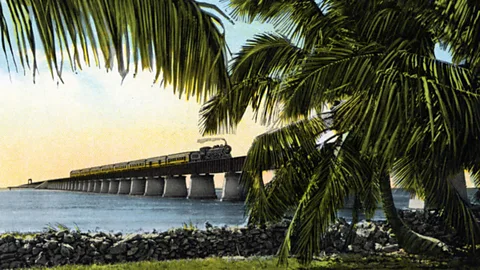 State Archives of Florida / Florida Memory/Alamy
State Archives of Florida / Florida Memory/Alamy“The fact that Flagler funded [more than $30m of this] out of his own pocket back in the day was pretty remarkable,” said Florida historian Brad Bertelli. “Jeff Bezos or Bill Gates might be able to do it today. Elon Musk with his SpaceX might be the best modern comparison.”
The railroad operated until 1935, when the deadliest hurricane in a century swept away miles of tracks. Instead of being rebuilt, Flagler’s masterwork was reincarnated to accommodate Americans’ newfound love of automobiles. In 1938, the US government set out to construct one of the longest overwater roads in the world by relying on Flagler’s seemingly indestructible bridges, which could withstand 200mph winds. Crews paved over the rails to accommodate cars, and the newly opened Overseas Highway forever transformed the far-flung Florida Keys into the thriving tourist destination they are today.
More than a century after the railroad’s completion, 20 of the original bridges still carry travellers from Miami to Key West. You can make the drive in under four hours, but detouring along the way is part of the fun. A series of fascinating, under-the-radar stops helps travellers better appreciate how this engineering marvel came to be, and its lasting impact on the Florida Keys.
Sixty-nine miles south of Miami, Key Largo is the northernmost of the Florida Keys and great first stop. Gators, snakes and other water-bound critters may have terrified Flagler’s construction crews, but these days, travellers come to Key Largo (the self-proclaimed “dive capital of the world”) to marvel at its abundant marine life. The Florida Keys National Marine Sanctuary adjoining John Pennekamp Coral Reef State Park attracts snorkelers and divers eager to immerse themselves in North America’s only living coral barrier reef. The seagrass beds here provide a critical habitat for fish, manatees and sea turtles, but the main attraction is swimming into the outstretched arms of Christ of the Deep, a submerged 9ft-tall bronze statue of Jesus that has been watching over visitors since 1965.
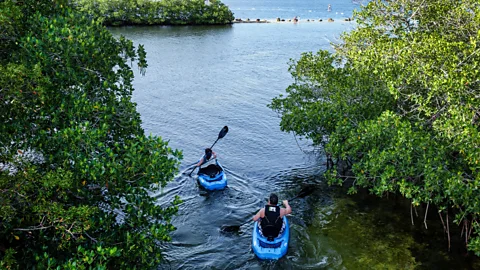 Jeffrey Isaac Greenberg 8+/Alamy
Jeffrey Isaac Greenberg 8+/AlamyOnce you’ve dried off, head to Islamorada, a community halfway between Miami and Key West that was once the site of an Over-Sea Railroad station. Here, at the Keys History & Discovery Center, a 35-minute documentary highlights the railroad’s construction and its many obstacles. The museum also presents artefacts from the train’s golden era, including dining car dishes, as well as an original menu showing that a sirloin steak cost $1.60.
From 1908 to 1912, about 400 workers lived in an encampment at Pigeon Key, a tiny coral island located 35 miles south of Islamorada, while constructing the most challenging portion of the Over-Sea Railroad: the famous Seven Mile Bridge (colloquially called the Old Seven) that connected the Middle and Lower Keys.
In 1909, civil engineer William J Krome was charged with the daunting task of crossing a 6.8-mile expanse of open water. Construction crews worked round the clock, driving more than 700 supporting pilings into the middle of the ocean, sometimes nearly 30ft below sea level, to build the route’s longest bridge. They were assisted by divers who helped create underwater concrete pedestals to support the weight of the rail track.
Remnants of the old construction camp can be accessed by taking a trolley across the old bridge from the city of Marathon to Pigeon Key. A 2.2-mile section (the only part that is accessible) reopened in January 2022 following a $44m, five-year renovation. Closed to non-trolley traffic, the once-decaying bridge is now a safe playground for those who want to cycle or rollerblade 65ft above the crystal-clear water or observe marine life, like sea turtles and nurse sharks.
Today, only four permanent residents live on Pigeon Key. The five-acre island is now a National Historic Landmark and is run primarily on solar power. It’s also home to a museum offering guided tours of several buildings that once housed workers, and chronicles what daily life for the crew was like as they built the Seven Mile Bridge.
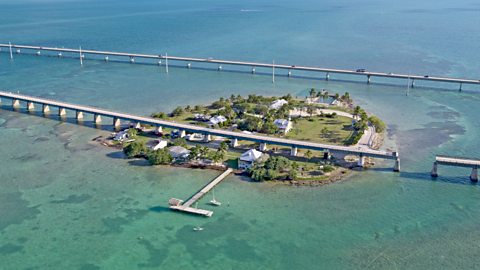 FL Stock/Alamy
FL Stock/AlamyThose driving the full length of the Overseas Highway today know the journey is complete when they see US Mile Marker 1 in Key West. The black and white buoy marks the southernmost point in the contiguous US, meaning travellers are now closer to Cuba (90 miles south) than Miami (132 miles north). But while many visitors head straight for the city’s main drag, Duval Street, or the Ernest Hemingway Home and Museum, the small-but-informative Sails to Rails Museum is worth a look.
The museum traces 500 years of Key West history, showing how this 7 sq mile tropical island evolved from a pirate haven to a trading hub to a tourist destination famous for its laid-back vibe. Artefacts from the railroad era include the paymaster’s car that served as a sort of mobile bank to deliver salaries to railroad employees. The Eighth Wonder of the Modern World exhibit highlights the railroad’s evolution and explains how each obstacle was eventually overcome by pushing the limits of early 20th-Century technology.
“If I had to single out the most influential event in the history of the Florida Keys, it would undoubtedly be the completion of Flagler’s Oversea Railway,” said Dr Cori Convertito, a Florida Keys historian and author. “Through his vision, dedication, enterprise and foresight, the Keys were, for the first time, connected to the American mainland. The commercial and travel advantages for residents and visitors to the island chain cannot be overstated. It forever influenced the trajectory of the Keys’ economy and opened the door to the tourism industry we have today.”
The Open Road is a celebration of the world’s most remarkable highways and byways, and a reminder that some of the greatest travel adventures happen via wheels.
Related
Canada says too little, too late as Trump flip-flops on…
Nadine Yousif and Ali Abbas AhmadiBBC News, TorontoWatch: Canadian liquor store clears out US alcohol in response to tariffsNot long after the US imposed their
Vietnam, Thailand, and Philippines Among Top Asian Destinations Most-Searched by…
Home » Philippines Travel News » Vietnam, Thailand, and Philippines Among Top Asian Destinations Most-Searched by American Travelers, Driven by Surge in Viet
Trump tariffs tarnish ties: Americans anxious about travel to Canada…
Will Trump's tariffs on Canadian goods entering the U.S. affect tourism at home, tarnishing ties Canadians and Americans have shared for decades? It's a fair qu
Looming Trump travel ban strikes fear in Afghans who worked…
Expectations that President Donald Trump will soon bar Afghans and Pakistanis from entering the United States has set off panic among Afghans who were promised












